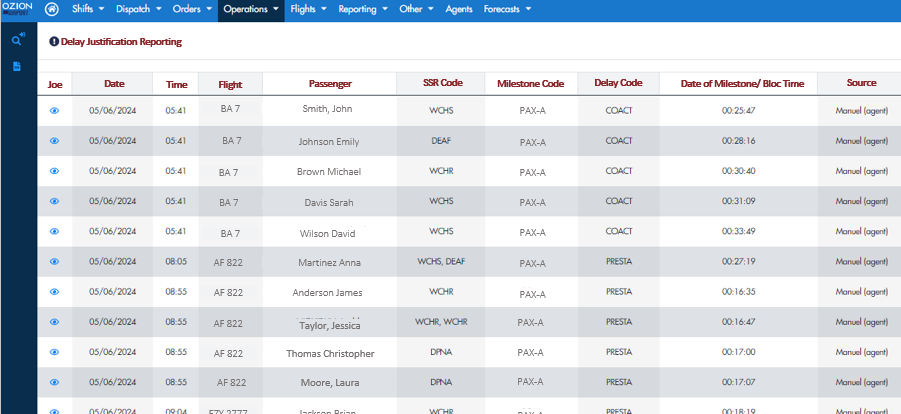
New Functionality; Passenger Boarding/Deboarding Delay Justification reporting
A recent addition allows for passenger boarding/deboarding delay justification to be recorded within PRM Manager, the occurrence of a delayed boarding/deboarding now prompts a request for justification of delay. The new default justifications for assistance delay include:
- ACCESS: Delayed access to aircraft boarding.
For example, due to an unexpected maintenance issue, the designated boarding gate was changed last minute, causing a delay in providing the necessary ramp access for the PRM. The passenger assistance team had to navigate through the terminal to reach the new gate, resulting in a 15-minute delay in boarding. - COACT: Challenges with coactivity on the RAMP.
For instance, the ambulift experienced technical difficulties while trying to dock with the aircraft. The alignment sensors malfunctioned, preventing the lift from safely attaching to the aircraft door. This issue caused a 20-minute delay as the ground crew manually adjusted the lift to ensure safe boarding. - CODIF: Incorrect identification of assistance requirement.
For example, A passenger was assigned the BLND (blind) SSR Code, indicating they needed minimal assistance. However, upon arrival, it was discovered that the passenger actually required a wheelchair and an additional helper for boarding, as they had limited mobility and needed to be carried. This discrepancy led to a 25-minute delay while the necessary resources were arranged. - HAND: Delays due to difficulties in passenger handling.
Such a scenario could be on a particular flight, there were five PRMs scheduled to deboard the aircraft, but an unexpected surge in passengers requiring assistance led to a total of 20 PRMs needing help. The assistance team was understaffed to handle this volume, causing staggered deboarding and a cumulative delay of 30 minutes. - NBPRM: Issues related to the volume of passengers needing assistance.
For example, on a particular flight, there were five PRMs scheduled to board, but an unexpected surge in passengers requiring assistance led to a total of ten PRMs needing help. The assistance team was understaffed to handle this volume, causing staggered boarding and a cumulative delay of 30 minutes. - PROV: Problems related to the service provider.
For instance, the service provider’s electric buggies used to transport PRMs across the terminal experienced a technical failure. Multiple buggies were out of service due to battery issues that were not identified during routine maintenance checks. As a result, the available buggies were insufficient to meet the demand, causing a significant delay in transporting PRMs to their gates. This equipment failure led to an average delay of 25 minutes per passenger for boarding and deboarding assistance.
By using clear delay cause justifications with default tags, software users now have access to precise categorization of delay causes. Delays are documented with specific, standardized reasons, providing actionable insights. Trends and patterns in delays can be quickly identified, leading to informed decision-making. This improves accountability and enhances performance by understanding the causes of delays. Targeted improvements can be made, ensuring a smoother and more efficient passenger experience. Overall, this feature transforms delay reporting into a valuable tool for continuous improvement and enhanced service delivery.

Monitoring a 10-Day Example
To illustrate the practical takeaway and insights of the delay justification feature, we will examine a 10-day period of active delay reporting. By analyzing this data, we aim to extract valuable insights into the specific causes of delays and their frequency. This period will help us identify trends, patterns, and recurring issues in passenger assistance. By doing so, we can better understand the impact of each delay reason and use this information to make informed decisions for process improvements.
| Date | PROV | NBPMR | ACCESS | CODIF | COACT | HAND |
| 26/05/2024 | 41% | 13% | 22% | 9% | 15% | 0% |
| 27/05/2024 | 63% | 17% | 11% | 4% | 6% | 0% |
| 28/05/2024 | 13% | 43% | 16% | 9% | 18% | 0% |
| 29/05/2024 | 57% | 21% | 11% | 5% | 6% | 0% |
| 30/05/2024 | 22% | 20% | 32% | 16% | 10% | 0% |
| 31/05/2024 | 46% | 26% | 19% | 0% | 9% | 0% |
| 01/06/2024 | 24% | 34% | 16% | 6% | 21% | 0% |
| 02/06/2024 | 26% | 33% | 21% | 5% | 16% | 0% |
| 03/06/2024 | 42% | 21% | 22% | 9% | 6% | 0% |
| 04/06/2024 | 44% | 31% | 13% | 6% | 6% | 0% |
The 10 day Analysis
The analysis of the 10-day active delay reporting period reveals key insights into the primary causes of service delays. Issues related to the service provider (PROV) emerged as the most frequent cause, averaging 38% and peaking at 63% of occurrences, indicating systemic problems that require urgent attention. The volume of passengers needing assistance (NBPMR) was the second most common cause, with a fluctuating average of 26%, potentially highlighting the need for better resource planning and scheduling. Delays due to access to board the aircraft (ACCES) remained consistent, averaging 18%, suggesting that infrastructure or procedural enhancements are necessary. Misrepresentation of assistance requirements (CODIF) and challenges with coactivity on the RAMP (COACT) showed moderate impact, with averages of 7% and 11%, respectively, pointing to the need for improved data accuracy and operational coordination. Notably, no delays were attributed to handling difficulties with passengers (HAND), indicating effective management in this area. Overall, addressing the prevalent issues identified in PRESTA and NBPRM categories, along with continuous monitoring and process refinement, will be crucial for enhancing service efficiency and passenger experience.
| Needs Immediate Attention | Needs Monitoring | No Immediate Attention Needed |
| PROV | NBPMR
ACCESS COACT |
CODIF
HAND |
Conclusion
The introduction of delay cause justification in PRM Manager 4.8 marks a significant advancement in delay record keeping. By providing precise categorization of delay causes through standardized reasons, this feature equips software users with actionable insights and enhanced accountability. The ability to quickly identify trends and patterns in delays allows for informed decision-making and targeted improvements, ultimately ensuring a smoother and more efficient passenger experience.
Our analysis of a 10-day active delay reporting period highlights the practical benefits of this feature. It reveals that issues related to the service provider (PROV) and the volume of passengers needing assistance (NBPRM) are the most frequent causes of delays, necessitating immediate attention and ongoing monitoring, respectively. Delays due to access to board the aircraft (ACCESS) also require monitoring for potential infrastructure or procedural enhancements. Meanwhile, other categories such as misrepresentation of assistance requirements (CODIF) and challenges with coactivity on the RAMP (COACT) showed moderate impact but do not currently necessitate immediate intervention.
By systematically addressing these delay causes, stakeholders can drive continuous improvements in service delivery, ensuring a higher standard of care for all passengers. This feature thus transforms delay reporting from a reactive measure into a proactive tool for enhancing operational efficiency and passenger satisfaction.


